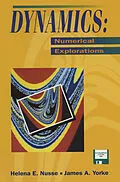Co-author J.A. Yorke developed an array of tools to help visualize the properties of dynamical systems, while Yorke found it useful to combine these various basic tools into one single package: Dynamics. The program together with this manual provides an introduction to and an overview of fundamental, sophisticated tools and numerical methods together with many simple examples. All numerical methods described in this handbook are implemented in the program, which is capable of, among others: iterating maps and solving differential equations; plotting trajectories; featuring an array of simple commands; printing a created picture in resolution higher than that of the screen. Requires a UNIX workstation running X11 graphics or a PC.
Inhalt
1. Getting the program running.- 1.1 The Dynamics program and hardware.- 1.2 Getting started with Dynamics.- Appendix: Description of the interrupts.- 2. Samples of Dynamics: pictures you can make simply.- 2.1 Introduction.- 2.2 Complex pictures that are simple to make.- Appendix: Command for plotting a graph and Commands from the Main Menu.- 3. Screen utilities.- 3.1 Clear or Refresh screen and set Text Level (Screen Menu SM).- 3.2 The arrow keys and boxes (BoX Menu BXM).- 3.3 Initializing trajectories, plotting crosses, drawing circles and their iterates (cross Menu KM).- 3.4 Drawing axes (AXes Menu AXM).- 3.5 Windows and rescaling (Window Menu WM).- 3.6 Setting colors (Color Menu CM and Color Table Menu CTM).- 4. Utilities.- 4.1 Setting parameters (Parameter Menu PM).- 4.2 Setting and replacing a vector (Vector Menu VM).- 4.3 Setting step size (Differential Equation Menu DEM).- 4.4 Saving pictures and data (Disk Menu DM).- 4.5 Setting the size of the core (Size of Core Menu SCM).- 4.6 Printing pictures (PriNter Menu PNM).- 5. Dimension and Lyapunov exponents.- 5.1 Introduction and the Methods.- 5.2 Lyapunov Menu LM.- 5.3 Examples.- 5.4 Exercises.- 5.5 References related to Dynamics.- 6. Bifurcation diagrams.- 6.1 Introduction and the Methods.- 6.2 BIFurcation diagram Menu BIFM.- 6.3 Examples.- 6.4 Exercises.- 6.5 References related to Dynamics.- 7. Basins of attraction.- 7.1 Introduction and the Methods.- 7.2 Basin of attraction Menu BM.- 7.3 Examples.- 7.4 Exercises.- 7.5 References related to Dynamics.- 8. Straddle trajectories.- 8.1 Introduction and the Methods.- 8.2 Straddle Trajectory Menu STM.- 8.3 Examples.- 8.4 Exercises.- 8.5 References related to Dynamics.- 9. Unstable and stable manifolds.- 9.1 Introduction and the Methods.- 9.2 Unstable and stable manifold Menu UM.- 9.3 Examples.- 9.4 Exercises.- 9.5 References related to Dynamics.- 10. Finding periodic orbits.- 10.1 Introduction and the Methods.- 10.2 Periodic Orbit Menu POM.- 10.3 Examples.- 10.4 Exercises.- 10.5 References related to Dynamics.- 11. Following periodic orbits.- 11.1 Introduction and the Methods.- 11.2 Follow Orbit Menu FOM.- 11.3 Examples.- 11.4 Exercises.- 11.5 References related to Dynamics.- 12. Changing the program.- 12.1 Modifying a process: Recompiling the program.- 12.2 Adding a new map.- 12.3 The vector y and computing Lyapunov exponents.- 12.4 Adding a new differential equation.- 12.5 Getting data printed out or sent to a file.- 13. Dynamics on Unix systems.- 14. Appendix.- 14.1 The map Q.- 14.2 Alphabetical list of the (sub)menus.- 14.3 Tree of the menus.- 14.4 List of menu commands.- 14.5 Tables of the Figures.- 15. References.- 16. Index of the commands and terms.
